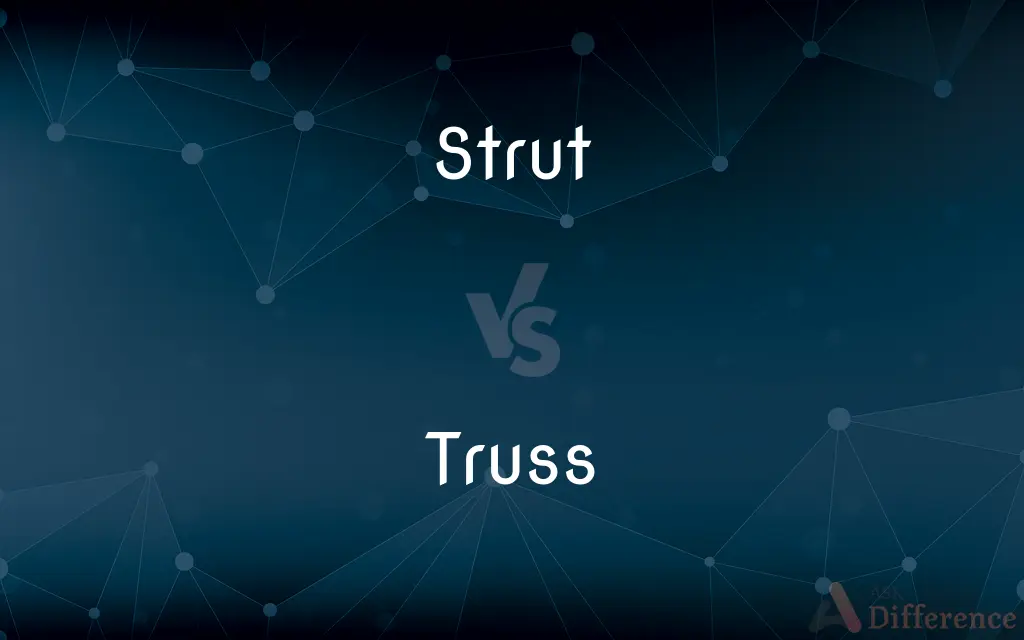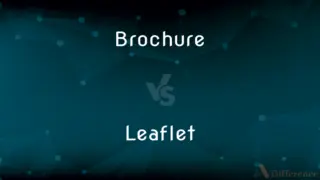Strut vs. Truss — What's the Difference?
By Fiza Rafique & Urooj Arif — Updated on March 22, 2024
A strut is a structural component designed to resist compression, often found in frameworks, while a truss is a framework composed of struts, beams, and other elements, designed to support loads over a span.

Difference Between Strut and Truss
Table of Contents
ADVERTISEMENT
Key Differences
A strut is a specific type of structural component, usually a straight, slender bar used primarily to resist compression.On the other hand, a truss is an assembly of beams or other elements that creates a rigid framework. Trusses are commonly used to span large distances and support roofs, bridges, and floors. They distribute weight efficiently, often incorporating a series of triangles within their design, because a triangle is inherently stable and capable of carrying loads without changing shape.
Struts can be components of a truss, functioning within the truss to resist specific forces. Struts are essential in various applications, including the construction of buildings, bridges, and towers, where they provide stability and support to parts of the structure that are prone to buckling under the force of compression. This differentiation highlights the complexity and adaptability of truss structures in comparison to the more straightforward, singular function of struts.
While struts focus on combating compressive forces, trusses are designed to manage a broader range of structural demands, including tension and compression, across larger spans. The design of a truss aims to provide a lightweight yet strong structure that maximizes the efficiency of material use, often allowing for significant spans with minimal material.
In the context of engineering and architecture, the distinction between a strut and a truss is significant. A strut is a single element with a specific role, whereas a truss is a composite structure that employs a combination of elements, including struts, to achieve stability and support over a wide area.
Comparison Chart
Definition
A structural component designed to resist compression.
A framework composed of various elements, designed to support loads.
ADVERTISEMENT
Function
Primarily resists compressive forces.
Supports loads over a span, managing both tension and compression.
Composition
A single straight, slender bar or component.
An assembly of beams, struts, and other components.
Application
Used in buildings, vehicles, and machinery for support.
Used to span large distances in roofs, bridges, and floors.
Structural Role
Provides stability and prevents buckling under compression.
Distributes weight and provides extensive support and stability.
Compare with Definitions
Strut
A structural component resisting compression.
The roof's stability is enhanced by the addition of steel struts.
Truss
A framework supporting loads over spans.
The warehouse was designed with a steel truss roof to cover the wide space efficiently.
Strut
Often used to prevent buckling in slender structures.
Struts were added to the slender columns for extra support.
Truss
Used in both architectural and engineering contexts.
Truss designs are critical in the construction of large-span buildings.
Strut
Provides localized support within larger structures.
Each strut in the framework plays a crucial role in overall stability.
Truss
Can be made from wood. steel. or other materials.
Wooden trusses are commonly used in residential roof construction.
Strut
Integral in vehicle suspension systems.
The car's smooth ride is due to its high-quality suspension struts.
Truss
Incorporates triangles for stability.
The bridge's strength comes from its triangular truss design.
Strut
Can be adjustable or fixed in length.
The adjustable struts allow for changes in the load distribution.
Truss
Enables efficient material use for large spans.
The truss system allowed for a spacious open-concept design without intermediate columns.
Strut
A strut is a structural component commonly found in engineering, aeronautics, architecture and anatomy. Struts generally work by resisting longitudinal compression, but they may also serve in tension.
Truss
A truss is an assembly of beams or other elements that creates a rigid structure.In engineering, a truss is a structure that "consists of two-force members only, where the members are organized so that the assemblage as a whole behaves as a single object". A "two-force member" is a structural component where force is applied to only two points.
Strut
A rod or bar forming part of a framework and designed to resist compression
A spindly framework of long, slender struts, girders, and bracing wire
A supporting strut
Truss
(Medicine) A supportive device, usually a pad with a belt, worn to prevent enlargement of a hernia or the return of a reduced hernia.
Strut
A stiff, erect, and apparently arrogant or conceited gait
That old confident strut and swagger has returned
Truss
A rigid framework, as of wooden beams or metal bars, designed to support a structure, such as a roof.
Strut
Walk with a stiff, erect, and apparently arrogant or conceited gait
She strutted down the catwalk
Peacocks strut through the grounds
Truss
An architectural bracket.
Strut
Brace (something) with a strut or struts
The holes were close-boarded and strutted
Truss
Something gathered into a bundle; a pack.
Strut
To walk with pompous bearing; swagger.
Truss
(Nautical) An iron fitting by which a lower yard is secured to a mast.
Strut
To display in order to impress others. Sometimes used with out
Don't strut out your resume until you have more accomplishments to list.
Truss
(Botany) A compact cluster of flowers at the end of a stalk.
Strut
To provide (a structure) with a strut or struts.
Truss
To tie up or bind tightly.
Strut
To brace or separate with a strut.
Truss
To bind or skewer the wings or legs of (a fowl) before cooking.
Strut
A pompous, self-important gait.
Truss
To support or brace with a truss.
Strut
A structural element used to brace or strengthen a framework by resisting stress or compression.
Truss
A bandage and belt used to hold a hernia in place.
Strut
(intransitive) Of a peacock or other fowl: to stand or walk stiffly, with the tail erect and spread out.
Truss
(architecture) A structure made up of one or more triangular units made from straight beams of wood or metal, which is used to support a structure as in a roof or bridge.
Strut
To walk haughtily or proudly with one's head held high.
He strutted about the yard, thinking himself master of all he surveyed.
Truss
(architecture) A triangular bracket.
Strut
To walk across or on (a stage or other place) haughtily or proudly.
Truss
An old English farming measurement. One truss of straw equalled 36 pounds, a truss of old hay equalled 56 pounds, a truss of new hay equalled 60 pounds, and 36 trusses equalled one load.
Strut
Often followed by out: to protuberate or stick out due to being full or swollen; to bulge, to swell.
Truss
(obsolete) A bundle; a package.
Strut
Often followed by out: to cause (something) to bulge, protrude, or swell.
Truss
(historical) A padded jacket or dress worn under armour, to protect the body from the effects of friction.
Strut
To brace or support (something) by a strut or struts; to hold (something) in place or strengthen by a diagonal, transverse, or upright support.
Truss
(historical) Part of a woman's dress; a stomacher.
Strut
(intransitive) To be attached diagonally or at a slant; also, to be bent at a sharp angle.
Truss
(botany) A tuft of flowers or cluster of fruits formed at the top of the main stem of certain plants.
Strut
A step or walk done stiffly and with the head held high, often due to haughtiness or pride; affected dignity in walking.
Truss
(nautical) The rope or iron used to keep the centre of a yard to the mast.
Strut
(historical) An instrument for adjusting the pleats of a ruff.
Truss
(transitive) To tie up a bird before cooking it.
Strut
A beam or rod providing support.
Truss
(transitive) To secure or bind with ropes.
Strut
An act of angle]]; specifically, deviation (of the spoke of a wheel) from the normal position.
Truss
(transitive) To support.
Strut
(obsolete) Swelling out due to being full; bulging, protuberant, swollen.
Truss
To take fast hold of; to seize and hold firmly; to pounce upon.
Strut
Drunk, intoxicated; fou.
Truss
To strengthen or stiffen, as a beam or girder, by means of a brace or braces.
Strut
To swell; to bulge out.
The bellying canvas strutted with the gale.
Truss
To execute by hanging; to hang; usually with up.
Strut
To walk with a lofty, proud gait, and erect head; to walk with affected dignity.
Does he not hold up his head, . . . and strut in his gait?
Truss
A bundle; a package; as, a truss of grass.
Bearing a truss of trifles at his back.
Strut
The act of strutting; a pompous step or walk.
Truss
A padded jacket or dress worn under armor, to protect the body from the effects of friction; also, a part of a woman's dress; a stomacher.
Puts off his palmer's weed unto his truss, which boreThe stains of ancient arms.
Strut
In general, any piece of a frame which resists thrust or pressure in the direction of its own length. See Brace, and Illust. of Frame, and Roof.
Truss
A bandage or apparatus used in cases of hernia, to keep up the reduced parts and hinder further protrusion, and for other purposes.
Strut
Any part of a machine or structure, of which the principal function is to hold things apart; a brace subjected to compressive stress; - the opposite of stay, and tie.
Truss
A tuft of flowers formed at the top of the main stalk, or stem, of certain plants.
Strut
Protuberant.
Truss
The rope or iron used to keep the center of a yard to the mast.
Strut
Struthious.
Truss
An assemblage of members of wood or metal, supported at two points, and arranged to transmit pressure vertically to those points, with the least possible strain across the length of any member. Architectural trusses when left visible, as in open timber roofs, often contain members not needed for construction, or are built with greater massiveness than is requisite, or are composed in unscientific ways in accordance with the exigencies of style.
Strut
A proud stiff pompous gait
Truss
To bind or pack close; to tie up tightly; to make into a truss.
It [his hood] was trussed up in his wallet.
Strut
Brace consisting of a bar or rod used to resist longitudinal compression
Truss
To take fast hold of; to seize and hold firmly; to pounce upon.
Who trussing me as eagle doth his prey.
Strut
To walk with a lofty proud gait, often in an attempt to impress others;
He struts around like a rooster in a hen house
Truss
To strengthen or stiffen, as a beam or girder, by means of a brace or braces.
Truss
To skewer; to make fast, as the wings of a fowl to the body in cooking it.
Truss
To execute by hanging; to hang; - usually with up.
Truss
(medicine) a bandage consisting of a pad and belt; worn to hold a hernia in place by pressure
Truss
A framework of beams forming a rigid structure (as a roof truss)
Truss
(architecture) a triangular bracket of brick or stone (usually of slight extent)
Truss
Tie the wings and legs of a bird before cooking it
Truss
Secure with or as if with ropes;
Tie down the prisoners
Tie up the old newspapes and bring them to the recycling shed
Truss
Support structurally;
Truss the roofs
Trussed bridges
Common Curiosities
How does a truss differ from a single beam?
A truss differs from a single beam by distributing loads across a more complex framework, often allowing it to span larger distances with less material.
Are struts used outside of construction?
Yes, struts are used in various fields, including automotive, aerospace, and machinery, for their structural support capabilities.
What makes a truss more efficient than a solid beam?
The efficiency of a truss lies in its ability to distribute loads across a network of interconnected elements, reducing material use while maintaining strength.
What is the primary function of a strut?
The primary function of a strut is to resist compressive forces, providing stability and support to structures.
How is the design of a truss determined?
The design of a truss is determined by the specific loads it needs to support, the span to be covered, and the material efficiency required.
How do engineers decide between using a strut or a truss?
The decision depends on the structural requirements, including the type of loads, the span, and the desired efficiency of material use.
Can the design of a truss affect its load-bearing capacity?
Yes, the configuration and connectivity of the truss's components directly influence its ability to bear and distribute loads.
Can trusses only be used for horizontal spans?
No, trusses can be used both horizontally and vertically, as well as in various angles, depending on the design requirements.
What role do materials play in the effectiveness of struts and trusses?
The choice of materials affects the strength, durability, and weight of struts and trusses, impacting their overall effectiveness and application.
Can a strut also experience tension?
While struts are primarily designed to resist compression, depending on the structure's design, they can also experience tension.
Are all trusses triangular?
While many trusses use triangular configurations for stability, there are various designs, including some that incorporate different shapes to meet specific structural needs.
What advancements have been made in truss design?
Advancements include the use of lightweight, high-strength materials, computer-aided design (CAD) for optimization, and modular truss systems for quicker assembly.
What is the significance of a strut in a suspension system?
In a suspension system, a strut provides support and absorbs shock, contributing to the vehicle's stability and ride comfort.
How do environmental factors influence the design of trusses and struts?
Environmental factors, such as wind, snow loads, and seismic activity, must be considered in the design to ensure stability and durability.
What is the importance of maintenance for struts and trusses?
Regular maintenance is crucial for ensuring the long-term stability and safety of structures utilizing struts and trusses, preventing failure due to wear, corrosion, or damage.
Share Your Discovery

Previous Comparison
Manager vs. Consultant
Next Comparison
Brochure vs. LeafletAuthor Spotlight
Written by
Fiza RafiqueFiza Rafique is a skilled content writer at AskDifference.com, where she meticulously refines and enhances written pieces. Drawing from her vast editorial expertise, Fiza ensures clarity, accuracy, and precision in every article. Passionate about language, she continually seeks to elevate the quality of content for readers worldwide.
Co-written by
Urooj ArifUrooj is a skilled content writer at Ask Difference, known for her exceptional ability to simplify complex topics into engaging and informative content. With a passion for research and a flair for clear, concise writing, she consistently delivers articles that resonate with our diverse audience.














































